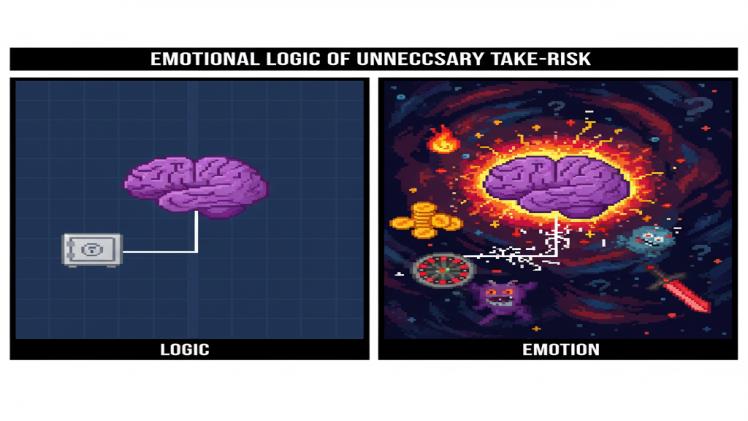Emotional Logic of Unnecessary Take-Risk
Why do we occasionally engage in things we are fully aware we do not even necessarily need–or prudently? Human beings are known to take unwarranted risks, whether it be ordering an additional dessert, pursuing a near-win at a casino table game, or simply making an impulse purchase of a digital collectable. And even though such behaviour may not be viewed as completely rational, neuroscience and behavioural economics would lead one to conclude that there is a strategy behind this emotional insanity.
Realizing Unnecessary Risks.
What Are Unnecessary Risks?
Unnecessary risks are decisions that offer little real value but carry the possibility of loss —consider climbing a fence to see what is on the other side, or going to bed late and scrolling through applications rather than getting sleep. They all have a similar appeal to emotions: they activate the brain’s reward system and give a thrill even when the reward is low-level or nonexistent.
Extravagant spending on digital games and impulsive purchasing, or even a daily routine involving sites like Bizzo Casino Greece, are all tendencies observed in real life. The reason is that our brains are sensitive to novelty and unpredictability.
Why We Find Risk Appealing
Risk-taking fulfils several psychological needs, emotionally. The expectation of a reward, however improbable, stimulates dopamine, producing a feeling commonly referred to as a rush. This is further intensified when the reward is variable: we learn to pursue uncertainty because it is the uncertainty that creates the thrill. Even the smallest risk can be irresistible due to behavioural patterns such as decision fatigue and cognitive bias.
The Neuroscience of Risk-Taking.
Brain Processes of Risk Behaviour.
The neural mechanism of risk-taking involves connections between the limbic system and the prefrontal cortex. The amygdala and striatum of the limbic system react to Excitement and fear, and the prefrontal cortex considers the long-term outcome. Dopamine surges make high-stimulus behaviour such as gambling, scrolling through variable-reward apps, and other activities more likely. When we engage in these behaviour, they add to the behaviour. Over time, these repetitions can create a feedback loop and push us toward even more dangerous decisions.
Why We Repeat Risky Behaviour
Humans, especially, feel the need to respond to variable rewards, a type of reward frequently found in digital environments. The uncertainty of a victory, or even the perception of a close win, triggers the circuitry linked to pleasure.
| Risk Type | Brain Region Activated | Neurochemical Response | Emotional Effect | Likely Outcome |
| Casino table games | Striatum, Prefrontal Cortex | Dopamine spike | Excitement, anticipation | Win/loss cycle |
| Extreme sports | Amygdala, Nucleus Accumbens | Adrenaline, Dopamine | Thrill, fear | Safety vs injury |
| Impulsive digital buys | Orbitofrontal Cortex | Dopamine surge | Satisfaction, regret | Financial stress |
This table shows that, regardless of whether the risk is physical, financial, or digital, the same emotional mechanisms and chemical processes are involved.
Online Spaces and Taking Risks.
Online Channels and Circuits of Interaction.
Social applications and various online casinos leverage these neural responses. An example of a site that uses engagement loops — such as variable rewards, immediate gratification, and aesthetically pleasing design — to motivate risk-taking without coercing it out of users is Bizzo Casino Greece. It is not about making users roll dice and possibly lose; it is about giving them moments that spark curiosity, Excitement, and a desire to play more than once.
Table Games at the Casino and Logic.
Take a look at traditional casino table games. It is not that winning is always exciting, but only that one has a glimpse of what might happen, the patterns of reading, and a sense of power, despite its illusion.
Looser Digital Risk Examples.
There is no unnecessary risk in the digital age that is limited to gambling. All of these problems—social media, trading applications on the internet, and in-game—are using the same emotional stimuli: novelty, uncertainty, and immediate reward. The brain tends to react to such situations in the same emotional way it does when it is betting at the roulette table, and that is why seemingly insignificant actions can turn out to be so compulsive.
Expert Assessment
According to behavioural economists and neuroscientists, these patterns are elements of a basic human wiring. We have a natural attraction to encounters involving uncertainty, possible payoff, and emotional arousal. Casinos (including online casinos) take advantage of this wiring, not to get us addicted, but to appeal to our natural desire for thrills and to find something new and exotic.
It is not necessarily a bad thing to be involved with risk–this is what makes human decisions dynamic, adaptive and, at times, wonderfully irrational. The point is to see the emotional rationale of these decisions. By understanding the dopamine loops, cognitive biases, and behavioural habits in the workplace, we can navigate our impulses more easily, whether in the virtual or real world.
